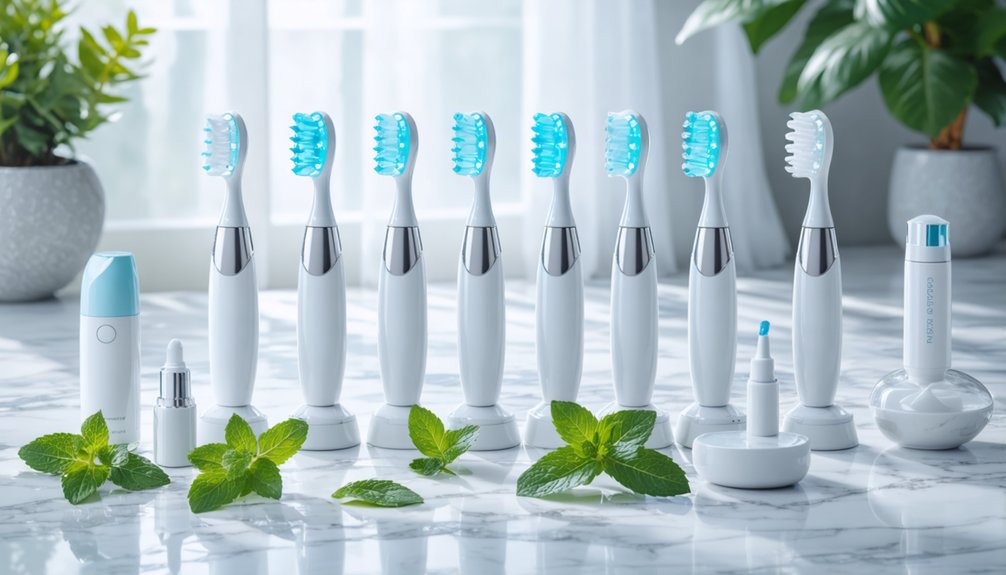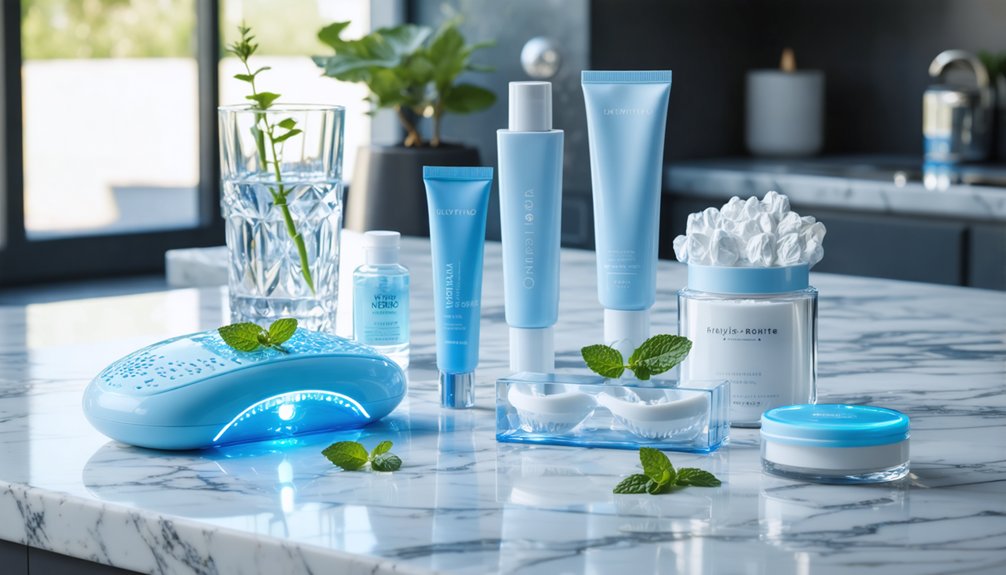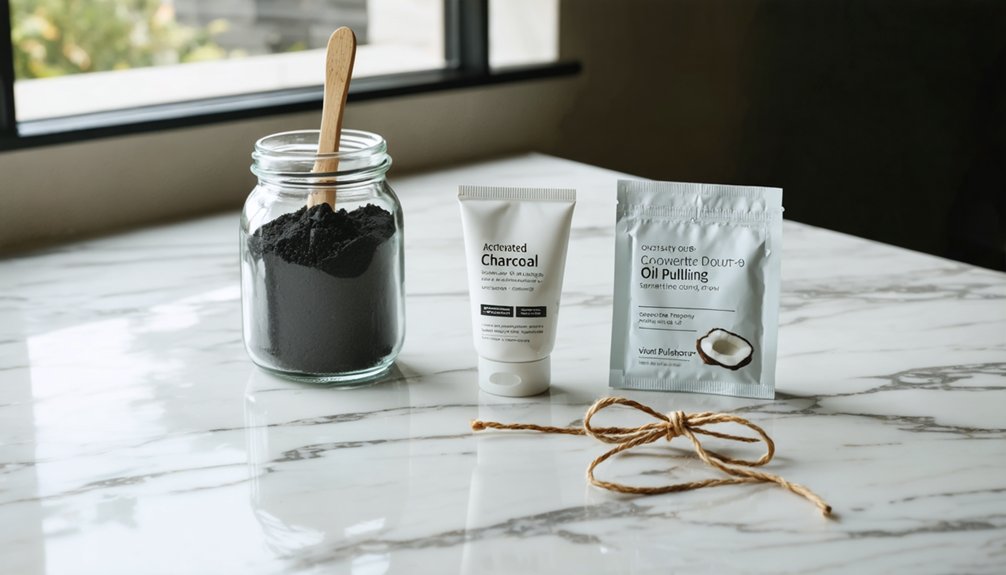You’ll find effective over-the-counter whitening options even with sensitive teeth, thanks to modern formulations with gentle peroxide levels and protective ingredients. Top choices include Crest 3D Whitestrips Sensitive + LED Light, low-peroxide whitening gels with calcium lactate gluconate, and professional-grade kits like Opalescence. For ultra-sensitive teeth, consider peroxide-free strips with natural ingredients like sage oil or custom-fit trays with desensitizing agents. Understanding the right combination of products and application methods can maximize your results while minimizing discomfort.
Key Takeaways
- Crest 3D Whitestrips Sensitive + LED Light offers professional-level whitening with enamel-safe ingredients and a gentle 14-day treatment plan.
- Products containing potassium nitrate and fluoride help reduce sensitivity while whitening, such as Sensodyne Clinical White.
- Low-peroxide whitening gels with calcium lactate gluconate protect enamel while effectively removing stains.
- Natural alternatives like peroxide-free strips with sage oil provide gentler whitening for extremely sensitive teeth.
- Opalescence whitening products combine hydrated silica and arginine to seal exposed dentin while removing surface stains.
Understanding Teeth Sensitivity and Whitening
While teeth whitening remains a popular cosmetic dental procedure, understanding its relationship with sensitivity is vital for safe treatment. Sensitivity affects about 12.3% of adults, with women experiencing it more frequently than men.
You’ll typically notice sharp, temporary pain when consuming hot, cold, sweet, or sour items. Recent studies show that 1 in 2 adults experience some form of tooth sensitivity pain throughout their lives. Visual analog scales are commonly used by dental professionals to assess and document sensitivity levels.
The primary sensitivity causes stem from exposed dentin due to enamel loss or gum recession. At-home whitening can exacerbate these issues, especially if you’re already prone to sensitivity.
Your oral hygiene routine, including aggressive brushing or using certain products, may also contribute to the condition. Before starting any whitening treatment, it’s important to address existing sensitivity issues and rule out other dental problems like cavities or gum disease through professional evaluation.
Best Gentle Whitening Strips for Sensitive Teeth
For those with sensitive teeth seeking whiter smiles, gentle whitening strips offer an effective at-home solution that minimizes discomfort.
Crest 3D Whitestrips Sensitive + LED Light combines enamel-safe ingredients with LED technology to remove stubborn stains while maintaining comfort. The 14-day treatment plan delivers professional-level whitening results with daily 30-minute applications. Professional whitening treatments provide faster results but typically cost $300-1000. You’ll find their Gentle Routine variant particularly suitable with its lower peroxide concentration.
If you’re looking for alternative whitening options, consider strips containing natural remedies like sage oil, coconut oil, and sea salt.
These peroxide-free formulations effectively lift stains without compromising enamel integrity. For best results, pair your chosen strips with a desensitizing toothpaste and follow the recommended 30-minute treatment duration.
Don’t exceed daily usage guidelines, and discontinue use if sensitivity increases markedly.
Low-Peroxide Whitening Gels That Won’t Hurt
When using low-peroxide whitening gels, you’ll want to apply them with clean, dry hands onto thoroughly brushed teeth using the included applicator brush or tray.
You can maximize safety by choosing products containing protective ingredients like calcium lactate gluconate, which helps remineralize enamel during the whitening process. Most products contain hydrogen peroxide concentrations between 3-20% in over-the-counter formulations.
Recent research shows that non-peroxide strips can effectively whiten teeth without causing significant side effects. To prevent sensitivity, avoid applying excess gel that might contact your gums, and strictly follow the recommended treatment duration – typically 30 minutes or less for OTC products.
Safe Application Methods
Since sensitive teeth require special care during whitening, selecting the right peroxide concentration and application method is crucial for successful treatment. Professional guidance can help determine if you need in-chair treatments instead of at-home options.
For safe gel application, use a rice-sized amount per tooth, applying it to the inner front surface of your whitening tray. Position the tray carefully to guarantee a snug fit without gaps, which prevents gel from leaking onto sensitive gum tissue. Always ensure your whitening product contains ADA-approved concentrations of hydrogen peroxide for safe and effective results.
Follow these whitening tray tips for best results:
Start with short 30-minute sessions and gradually increase wear time if you don’t experience discomfort.
Clean and dry your trays thoroughly before each use.
Remove any excess gel from your gums immediately using a tissue or soft brush.
Don’t apply gel to teeth with crowns or restorations, as the whitening agent won’t affect these surfaces and may cause sensitivity.
Protective Ingredients Explained
Understanding protective ingredients in whitening gels starts with the two main peroxide agents: hydrogen peroxide (H2O2) and carbamide peroxide (CP). While both effectively whiten teeth, CP breaks down more slowly, making it gentler for sensitive teeth.
You’ll find that H2O2 at 6% equals roughly the strength of 18% CP, but with a faster action. CP takes up to 4 hours to fully break down, providing a more gradual whitening effect. Patients who experience tooth sensitivity should consider that peroxide concentrations matter significantly when choosing a whitening product.
Modern whitening formulas incorporate key protective ingredients to minimize discomfort. Potassium nitrate helps reduce nerve sensitivity, while fluoride strengthens your enamel during treatment.
Look for products containing glycerin and carbomer, which maintain moisture and help the gel adhere properly. Some formulations also include natural soothing agents like peppermint oil.
These protective elements work together to deliver effective whitening while safeguarding your teeth and gums from irritation.
Desensitizing Toothpastes With Whitening Power
When choosing a whitening toothpaste for sensitive teeth, you’ll want to look for active ingredients like potassium nitrate that create a protective barrier while gradually removing surface stains.
You can safely use these specialized formulas twice daily, focusing on gentle brushing techniques and following the recommended two-minute duration.
If you’re combining desensitizing toothpaste with other whitening treatments, make sure you’re using them at different times of day to maximize effectiveness while minimizing potential irritation.
Active Ingredients That Work
Modern desensitizing toothpastes combine proven active ingredients to both whiten teeth and reduce sensitivity.
You’ll find potassium nitrate as a key component, effectively blocking nerve signals that cause discomfort. Stannous fluoride creates a protective barrier while strengthening your enamel, and nano-hydroxyapatite delivers dual benefits by rebuilding enamel structure and enhancing whitening efficacy.
For gentle yet effective stain removal, look for formulations containing hydrated silica, which polishes without damaging sensitive teeth.
Arginine works to seal exposed dentin tubules, providing lasting relief. When selecting a product, prioritize those with multiple active ingredients that work synergistically.
Professional-grade options like Opalescence and Sensodyne Clinical White demonstrate strong clinical evidence for both sensitivity relief and whitening results while maintaining enamel integrity.
Safe Daily Usage Methods
To achieve ideal results while protecting sensitive teeth, implementing a systematic approach to daily desensitizing toothpaste use is essential. Start by using your desensitizing toothpaste at least two weeks before beginning any whitening treatment to build up protection against sensitivity.
For effective daily brushing and sensitivity management, use a soft-bristled brush with lukewarm water, brushing gently for three minutes, three times daily.
You’ll want to maintain consistent use throughout your whitening period while avoiding aggressive brushing techniques that could compromise enamel integrity. Combine your routine with fluoride rinses to enhance protection, and avoid extremely hot or cold beverages during treatment.
If sensitivity increases, adjust your brushing frequency under professional guidance, but don’t discontinue use unless you experience adverse reactions.
Combining With Whitening Treatments
Successful whitening treatments can be enhanced by strategically combining desensitizing toothpastes with peroxide-based products.
For ideal sensitivity management, you’ll want to take into account the concentration of your whitening agent. Higher concentrations of carbamide peroxide (22%) or hydrogen peroxide (35%) work well with desensitizing toothpastes containing potassium nitrate or stannous fluoride.
Product layering is essential for effectiveness. You’ll get better results using desensitizing toothpaste consistently for up to a month before starting whitening treatments.
If you’re using high-concentration whitening products, choose a toothpaste with stannous fluoride to create a protective barrier over exposed dentin tubules.
For single-session treatments, potassium nitrate-based toothpastes can help reduce nerve sensitivity while maintaining whitening efficacy.
Custom-Fit Trays and Sensitivity-Safe Solutions
When managing tooth sensitivity during whitening treatments, custom-fit trays paired with sensitivity-safe solutions offer superior control and comfort compared to generic alternatives.
Custom trays, designed specifically for your dental structure, guarantee even distribution of whitening gel while minimizing gum irritation and sensitivity risks.
Under professional supervision, you’ll receive tailored whitening gel concentrations that match your sensitivity levels.
The precise fit of custom trays prevents gel leakage and allows for controlled application, reducing the risk of enamel stress and hypersensitivity.
Unlike OTC options that often cause uneven results and increased sensitivity, custom trays enable gradual whitening with professional-grade gels.
You’ll achieve more uniform, longer-lasting results while maintaining maximum comfort throughout your treatment, making custom trays an ideal choice for sensitivity-prone individuals.
Peroxide-Free Whitening Alternatives
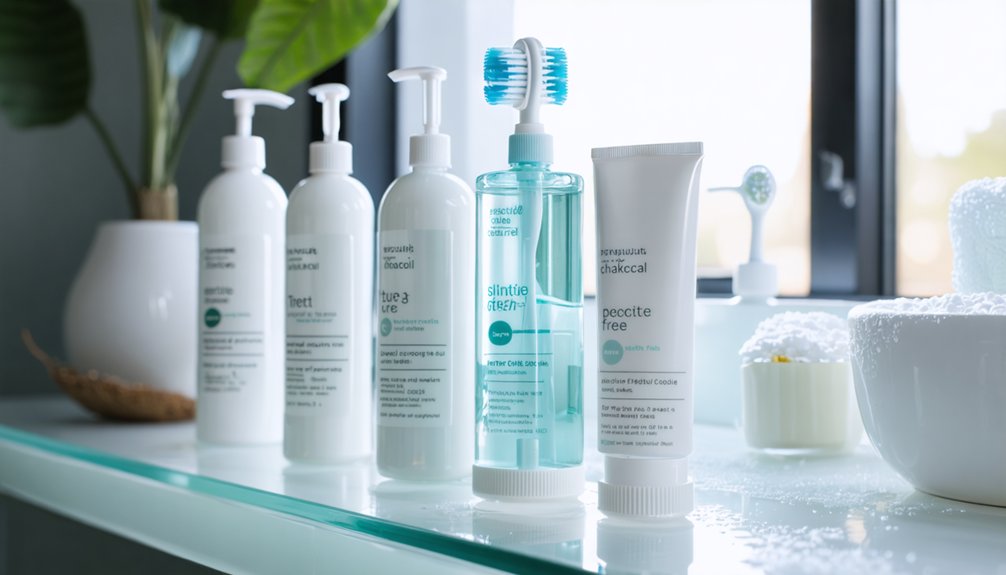
For individuals with sensitive teeth, peroxide-free whitening alternatives offer gentler options that minimize discomfort while still targeting surface stains. These peroxide alternatives primarily include PAP and bromelain, which work through oxidation or enzyme action rather than deep enamel bleaching.
When considering enamel safety and sensitivity, you’ll find these key features in peroxide-free products:
- No structural changes to enamel surface, as confirmed by microscopy studies
- Dissolving strips that require no rinsing and work in 15 minutes
- Natural enzyme-based formulas free from harsh chemicals like SLS and parabens
- Effective removal of surface stains without compromising enamel integrity
While these alternatives may not match hydrogen peroxide’s effectiveness for deep stains, they’re ideal if you’re prioritizing comfort and long-term enamel protection in your whitening routine.
Professional-Grade OTC Kits for Sensitive Smiles
When using professional-grade OTC whitening kits for sensitive teeth, you’ll achieve better results with custom-fit trays that guarantee even distribution of the whitening agent while minimizing gum exposure.
You should select formulas containing potassium nitrate and fluoride to help block nerve sensitivity and strengthen enamel during the whitening process.
It’s crucial to follow the manufacturer’s instructions carefully, avoiding extended wear times and checking for signs of increased sensitivity, which may require adjusting your treatment schedule.
Custom-Fit Trays Matter
Since professional-grade OTC whitening kits rely heavily on proper application methods, custom-fit trays serve as the cornerstone of effective treatment for sensitive teeth.
These precision-engineered trays maximize whitening efficiency while minimizing discomfort through their exact fit to your unique dental anatomy.
Consider these essential benefits of custom trays for sensitive teeth:
- Creates an airtight seal that prevents gel leakage and gum irritation
- Distributes whitening agents evenly across tooth surfaces for uniform results
- Maintains consistent contact between gel and enamel for ideal penetration
- Reduces waste by requiring less product than one-size-fits-all solutions
Your custom trays’ precise fit guarantees controlled application of professional-grade whitening agents while protecting sensitive gum tissue, making them an invaluable tool in achieving your desired results safely and comfortably.
Advanced Formula Safety Tips
While custom trays provide ideal application control, understanding advanced formula safety protocols maximizes the effectiveness of professional-grade OTC whitening treatments.
Recent whitening technology advancements have led to formulas with lower peroxide concentrations that still deliver impressive results. You’ll want to avoid products exceeding 10% hydrogen peroxide or 35% carbamide peroxide, as sensitivity research updates indicate these levels may increase discomfort.
Look for products bearing the ADA Seal of Acceptance and those containing clinically tested ingredients.
Professional-grade OTC kits often feature controlled application methods and customization options to reduce irritation. Before starting any treatment, conduct a pre-whitening sensitivity test and keep desensitizing products on hand.
If you experience persistent sensitivity, discontinue use immediately and consult your dentist.
Safe Application Methods to Minimize Discomfort
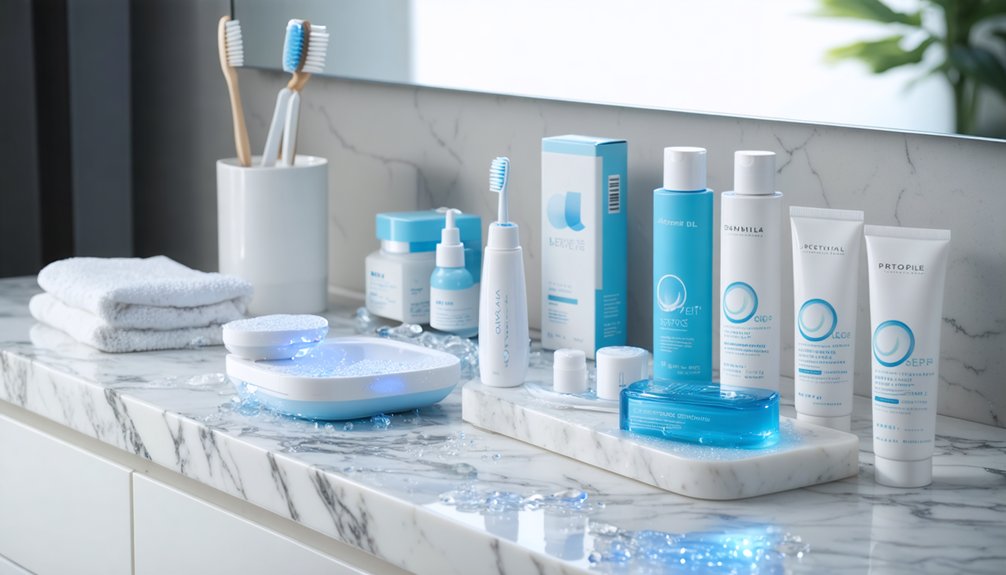
To minimize discomfort during teeth whitening, proper application methods play a crucial role in achieving safe and effective results. By understanding common sensitivity triggers and prioritizing enamel protection, you’ll create a more comfortable whitening experience for yourself or your patients.
- Apply whitening gel in thin, even layers using custom-fitted trays to prevent excess product pooling and gum irritation.
- Space treatments across multiple short sessions rather than one extended session, waiting 24-48 hours between applications.
- Use protective barriers on gums before applying whitening products, and rinse gently with fluoride solution afterward.
- Monitor sensitivity levels and adjust treatment frequency accordingly, avoiding hot, cold, or acidic foods during the whitening period.
Remember to maintain open communication with dental professionals and discontinue use if acute pain develops.
Natural Whitening Options for Ultra-Sensitive Teeth
Building on safe application methods, natural whitening alternatives offer promising solutions for those with highly sensitive teeth.
Consider natural oil pulling with coconut oil, which can reduce bacteria and plaque without harsh chemicals. You’ll want to swish for 15-20 minutes daily to achieve peak results while protecting your enamel integrity.
Oil pulling with coconut oil offers a gentle, natural way to whiten sensitive teeth while maintaining enamel health through daily practice.
For gentle surface stain removal, you can explore baking soda benefits when used sparingly.
Combine it with low concentrations of hydrogen peroxide to create a mild whitening paste, but avoid aggressive application that could wear down enamel.
Support these methods by reducing staining beverages like coffee and wine, while maintaining consistent oral hygiene practices.
Remember to stay hydrated, as proper saliva flow helps with natural remineralization and plaque control, contributing to a brighter smile without compromising sensitive teeth.
Combining Products for Maximum Results With Minimal Pain
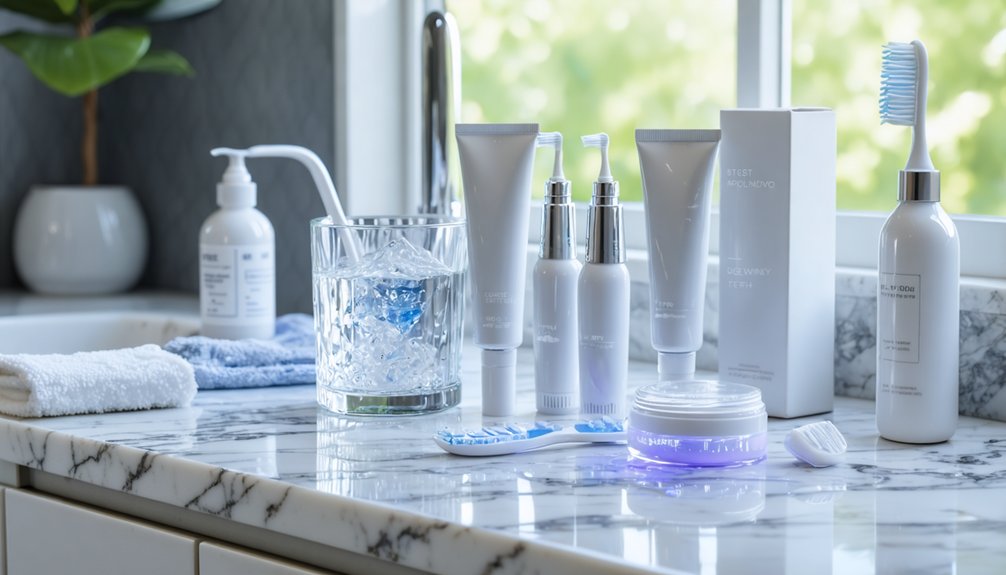
Effective whitening for sensitive teeth requires strategic product combinations that balance results with comfort.
For ideal sensitivity management while achieving noticeable whitening, you’ll want to pair lower concentration carbamide peroxide products with desensitizing agents containing potassium nitrate and fluoride.
Follow these steps to maximize results while minimizing discomfort:
- Begin with sensitive-formulated whitening toothpaste for two weeks.
- Introduce custom-fitted trays with low-concentration gel for controlled application.
- Apply remineralizing treatments between whitening sessions.
- Monitor tooth response to adjust whitening frequency accordingly.
Remember to alternate between whitening and soothing treatments, using products specifically designed for sensitive teeth.
Never combine multiple peroxide-based products simultaneously, as this can trigger heightened sensitivity and compromise your whitening progress.
Frequently Asked Questions
How Long Should I Wait Between Whitening Treatments if My Teeth Remain Sensitive?
You’ll need to wait 2-4 weeks between whitening treatments while actively managing sensitivity. If discomfort persists, extend your whitening frequency and consult your dentist for personalized guidance.
Can I Use Whitening Products While Wearing Clear Aligners or Retainers?
Like stars aligning in the night sky, you can safely whiten your teeth with aligners or retainers. Just verify whitening safety by choosing products specifically designed for aligner compatibility and following your orthodontist’s guidance.
Will Teeth Whitening Affect Existing Dental Work Like Crowns or Veneers?
Whitening products won’t change your crowns or veneers because they’re made of non-permeable materials. Your natural teeth will whiten, but restorations will stay the same color, potentially causing shade mismatches.
Does Drinking Through a Straw Prevent Staining During Whitening Treatment Periods?
Straw usage can help reduce staining during whitening, but won’t completely prevent it. You’ll get best results by positioning the straw toward the back of your mouth, away from front teeth.
Can Certain Medications Make Teeth More Sensitive to Whitening Products?
Yes, your medications can greatly increase tooth sensitivity to whitening products. You’ll need careful sensitivity management through reduced treatment times and lower peroxide concentrations to protect your teeth while whitening.
References
- https://www.westriverdentalcare.com/best-teeth-whitener-for-sensitive-teeth/
- http://www.goochlanddentistry.com/whats-the-best-teeth-whitener-for-sensitive-teeth/
- https://nhdentistrybeverlyhills.com/press/6-of-the-best-teeth-whitening-kits-in-the-drugstore/
- https://www.oxforddental.com/best-teeth-whitening-options-for-sensitive-teeth/
- https://buforddentist.com/what-are-the-best-whitening-options-for-sensitive-teeth/
- https://pmc.ncbi.nlm.nih.gov/articles/PMC3819160/
- https://pmc.ncbi.nlm.nih.gov/articles/PMC11326452/
- https://www.haleon.com/news/press-releases/brand/2023/new-study-reveals-now-1-in-2-adults-are-sufferung-the-pain-of-tooth-sensitivity
- https://professional.sunstargum.com/en-en/news-events/tooth-sensitivity-facts-and-research-for-professionals.html
- https://www.glaciercreekdental.com/tooth-sensitivity-1-in-8-americans-have-it/
